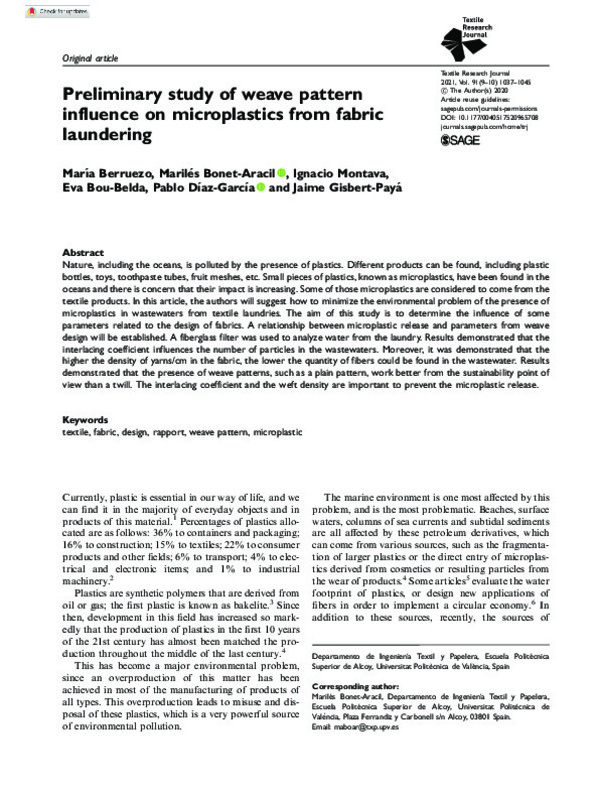JavaScript is disabled for your browser. Some features of this site may not work without it.
Buscar en RiuNet
Listar
Mi cuenta
Estadísticas
Ayuda RiuNet
Admin. UPV
Preliminary study of weave pattern influence on microplastics from fabric laundering
Mostrar el registro sencillo del ítem
Ficheros en el ítem
| dc.contributor.author | Berruezo, María
|
es_ES |
| dc.contributor.author | BONET-ARACIL, MARILÉS
|
es_ES |
| dc.contributor.author | Montava-Seguí, Ignacio
|
es_ES |
| dc.contributor.author | Bou-Belda, Eva
|
es_ES |
| dc.contributor.author | Díaz-García, Pablo
|
es_ES |
| dc.contributor.author | Gisbert Paya, Jaime
|
es_ES |
| dc.date.accessioned | 2021-11-11T19:30:53Z | |
| dc.date.available | 2021-11-11T19:30:53Z | |
| dc.date.issued | 2021-05 | es_ES |
| dc.identifier.issn | 0040-5175 | es_ES |
| dc.identifier.uri | http://hdl.handle.net/10251/176993 | |
| dc.description.abstract | [EN] Nature, including the oceans, is polluted by the presence of plastics. Different products can be found, including plastic bottles, toys, toothpaste tubes, fruit meshes, etc. Small pieces of plastics, known as microplastics, have been found in the oceans and there is concern that their impact is increasing. Some of those microplastics are considered to come from the textile products. In this article, the authors will suggest how to minimize the environmental problem of the presence of microplastics in wastewaters from textile laundries. The aim of this study is to determine the influence of some parameters related to the design of fabrics. A relationship between microplastic release and parameters from weave design will be established. A fiberglass filter was used to analyze water from the laundry. Results demonstrated that the interlacing coefficient influences the number of particles in the wastewaters. Moreover, it was demonstrated that the higher the density of yarns/cm in the fabric, the lower the quantity of fibers could be found in the wastewater. Results demonstrated that the presence of weave patterns, such as a plain pattern, work better from the sustainability point of view than a twill. The interlacing coefficient and the weft density are important to prevent the microplastic release. | es_ES |
| dc.language | Inglés | es_ES |
| dc.publisher | SAGE Publications | es_ES |
| dc.relation.ispartof | Textile Research Journal | es_ES |
| dc.rights | Reserva de todos los derechos | es_ES |
| dc.subject | Textile | es_ES |
| dc.subject | Fabric | es_ES |
| dc.subject | Design | es_ES |
| dc.subject | Rapport | es_ES |
| dc.subject | Weave pattern | es_ES |
| dc.subject | Microplastic | es_ES |
| dc.subject.classification | INGENIERIA TEXTIL Y PAPELERA | es_ES |
| dc.title | Preliminary study of weave pattern influence on microplastics from fabric laundering | es_ES |
| dc.type | Artículo | es_ES |
| dc.identifier.doi | 10.1177/0040517520965708 | es_ES |
| dc.rights.accessRights | Abierto | es_ES |
| dc.contributor.affiliation | Universitat Politècnica de València. Departamento de Ingeniería Textil y Papelera - Departament d'Enginyeria Tèxtil i Paperera | es_ES |
| dc.description.bibliographicCitation | Berruezo, M.; Bonet-Aracil, M.; Montava-Seguí, I.; Bou-Belda, E.; Díaz-García, P.; Gisbert Paya, J. (2021). Preliminary study of weave pattern influence on microplastics from fabric laundering. Textile Research Journal. 91(9-10):1037-1045. https://doi.org/10.1177/0040517520965708 | es_ES |
| dc.description.accrualMethod | S | es_ES |
| dc.relation.publisherversion | https://doi.org/10.1177/0040517520965708 | es_ES |
| dc.description.upvformatpinicio | 1037 | es_ES |
| dc.description.upvformatpfin | 1045 | es_ES |
| dc.type.version | info:eu-repo/semantics/publishedVersion | es_ES |
| dc.description.volume | 91 | es_ES |
| dc.description.issue | 9-10 | es_ES |
| dc.relation.pasarela | S\419620 | es_ES |
| dc.subject.ods | 15.- Proteger, restaurar y promover la utilización sostenible de los ecosistemas terrestres, gestionar de manera sostenible los bosques, combatir la desertificación y detener y revertir la degradación de la tierra, y frenar la pérdida de diversidad biológica | es_ES |








